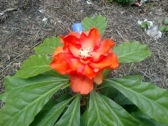Jarum Tujuh Bilah
| Jarum Tujuh Bilah | |
| Scientific Name | Pereskia bleo |
| Order | Lamiales |
| Family | Cactaceae (Cactus family) |
| Synonym |
Nyctanthes sambac L., Mogorium sambac (L) Lam., Jasminum sambac var. normale Kuntze |
 |
{slider=Common Name}
Leaf cactus, rose cactus, wax rose (English), Cak Sing Cam (Chinese)
{/slider}
{slider=Description}
Pereskia bleo is a leafy cactus (Pereskias only cactus with leaves), has thinner, corrugated leaves. The leaves of this plant are simple, glossy and wavy at the edges(Wiart, 2006). with distinct orange–red flowers (resembling rose blossoms) with shorter/sharp spines. The Malays call it 'Jarum Tujuh' which literally means 'Seven Needles' to indicate the sharp needle-like thorns on its stem, branches and axil. Unlike other leafless cacti species, this plant is not exactly a succulent and hence not drought-tolerant.Large and highly ornamental flowers with multiple thick orange petals that are arranged in almost the same manner as seen in roses. After flowering, plants produce interesting, funnel-looking fruits which ripen into a bright orange colour. Plants are propagated most easily via stem-cuttings. It is best grown in well-draining soil rich in organic matter and kept moist at all times.
{/slider}
{slider=Plant Material of Interest}
It has been spread throughout Central America and the Caribbean Islands as an ornamental species, and it is now incredibly popular in gardens and as landscaping plants. Its prickly nature can be exploited for using it to make a living fence.
{/slider}
{slider=General Appearance}
It is a small shrub or vine which grow to a height of 2 to 8 m.
{/slider}
{slider=Geographical Distribution}
Native to the shady, moist forests of Central America. This species occurs in Colombia and Panama (Leuenberger 1986, Hunt et al. 2006)
{/slider}
{slider=Traditional Uses}
Pereskia bleo, has also been used traditionally by the local ethnic groups in Malaysia for treatment of various ailments. The leaveseither eaten raw,chewedor taken as a concoction brewed and drink as a tea made from the mature leaves (6–7 pieces) is claimed to treat diabetes, hypertension, rheumatism and for revitalizing the body. (Abd. Malek et al., 2009 & Er et al., 2007).It also used as remedies for the relief of headache, gastric pain, ulcers, hemorrhoids, atopic dermatitis, and for revitalizing the body (Goh KL. 2002). There are also claims that the regular consumption of these leavescan be used to prevent and treat cancer, which resulted in its popularity among certain ethnic groups in Malaysia. The Berawans of Loagan Bunut, near Bintulu believe that this plant can help in curing cancer of the heart. They boil the leaves or its fruits and drink the boiled water after it has cooled down. But solid scientific evidence to support this belief is still not available as limited scientific studies have been done to date and all are still confined to the petri-dish In Singapore, it is a very important medicinal plant in their traditional medicine.It is also used to treat diabetes and hypertension in certain ethnic group (Tan et al., 2004). In Panama, the locals use the whole plant to treat gastrointestinal problems (Gupta et al.,) .
{/slider}
{slider=Chemical Constituents}
P. bleo produce a great deal of secondary metabolites many of them with versatile phramcological activities. These compounds include flavanoids, phenols,phenolic glycosides, saponins, cyanogenic glycosides, unsaturated lactones and glucosinolates (Calis et al., 1997; Emma et al., 2001; Podolak et al., 2007; Kappel et al., 2008)
{/slider}
{slider=Scientific Findings}
Antibacterial activity:
It is found that hexane and methanol extracts of Pereskia bleo showed highly and moderately, respectively, considerable antibacterial activity towards two Gram-negative bacteria, P. aeruginosa 60690 and S. choleraesuis. (S.I.A. Wahab et al., 2009)
Anti cancer activity:
Previous cytotoxic investigations on Pereskia bleo (Malek et al.,2009)reported that Pereskia bleo had cytotoxic effects on various cancer cell lines, using in vitro cytotoxic activity assays, but did not show cytotoxicity against the normal cell line. (Nurestri et al.,2008) The methanolic extract of Pereskia bleo was shown to be cytotoxic against a human mammary cancercell line, T47-D (Tan et al., 2005), thus suggesting it might be effective for the treatment of cancer.
{/slider}
{slider=Toxicity Studies}
The current study reports the outcome of acute oral toxicity investigation on ICR mice. No mortalities or evidence of adverse effects have been observed in ICR mice following acute oral administration at the highest dose of 2500 mg/ kg crude extracts of Pereskia bleo. This is the first report on the acute oral toxicity of Pereskia bleo and the findings of this study are in agreement with those of in vitro experiments and thus provide scientific validation on the use of the leaves of Pereskia bleo (Sim et al., 2010)
{/slider}
{slider=Reference}
Tan ML, Sulaiman SF, Najimuddin N, Samian MR and Muhammad TS. 2005. Methanolic extract of Pereskia bleo (Kunth) DC. (Cactaceae) induces apoptosis in breast carcinoma, T47-D cell line. J Ethnopharmacol, 96(1-2):287-94.
Er HM, Cheng EH and Radhakrishnan AK. 2007. Anti-proliferative and mutagenic activities of aqueous and methanol extracts of leaves from Pereskia bleo (Kunth) DC (Cactaceae). J Ethnopharmacol, 113(3):448-56.
Malek SN, Shin SK, Wahab NA and Yaacob H. 2009. Cytotoxic components of Pereskia bleo (Kunth) DC. (Cactaceae) leaves. Molecules, 14(5):1713-2
Sri Nurestri AM, Norhanom AW, Hashim Y, Sim KS, Hong SL, Lee GS, et al. Cytotoxic activity of Pereskia bleo (Cactaceae) against selected human cell lines. Int J Cancer Res 2008;4:20-7.
Sim K S, Sri Nurestri A M, Sinniah S K, Kim K H, Norhanom A W. Acute oral toxicity of Pereskia bleo and Pereskia grandifolia in mice. Phcog Mag 2010;6:67-70)
{/slider}
- Last updated on .
- Hits: 5582
